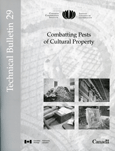If pest outbreaks do occur, they can be controlled in numerous ways, including: sanitizing affected areas, freezing, chemical pesticides, and oxygen depleted atmospheres.
Books and products we recommend:
 CCI Tech Bulletin #13 Controlling Vertebrate Pests in Museums by Thomas J.K. Strang and John E. Dawson
CCI Tech Bulletin #13 Controlling Vertebrate Pests in Museums by Thomas J.K. Strang and John E. Dawson
Examines the detrimental affect that rodents have on museum collections. Vertebrate animals can soil or destroy artifacts. Prompt identification of the pest and the use of suitable methods to control it are essential. In most cases, non-chemical methods can be used to control vertebrate pests in museums; chemical methods are also discussed.
| Controlling Vertebrate Pests in Museums | $12.00 |
 CCI Tech Bulletin # 15 Solving Museum Insect Problems: Chemical Control by John E. Dawson and revised by Thomas J.K. Strang
CCI Tech Bulletin # 15 Solving Museum Insect Problems: Chemical Control by John E. Dawson and revised by Thomas J.K. Strang
Intended to help museum staff understand commercial pest control operations. It describes chemical methods of controlling insects, and includes information on regulations, modes of action, and application methods necessary for the safe use of insecticides. A detailed guide helps in decision-making about the appropriate chemical method of control.
| Solving Museum Insect Problems: Chemical Control | $26.00 |
 CCI Tech Bulletin #29 Combatting Pests of Cultural Property by Tom Strang and Rika Kigawa
CCI Tech Bulletin #29 Combatting Pests of Cultural Property by Tom Strang and Rika Kigawa
Pests can be very destructive to both aesthetic elements and the structural integrity of collections, historic buildings, and objects. Protection against pests requires attention to the collection’s environment, containment, discovery of pests, response to pests, and remediation actions. Reducing loss of value over time is the goal of preventive conservation strategies. Integrated pest management (IPM) practices are part of this process. Having a safe work environment and minimizing adverse effects to objects from chemical exposure is a background concern. Effectiveness of any control procedure or treatment can be measured by reducing the extent and repeated incidence of the problem. Basic pests of collections, and a structured approach to pest reduction activities, are presented. A survey method with remediation activities appropriate to pest infestation findings is given to help start an IPM program for a wide range of collections from outdoor installations to state-of-the art preservation facilities.
| Combatting Pests of Cultural Property | $35.00 |
Links to related information on other sites:
Information Sheet No. 2 – Guidelines for Pest Control
http://www.slv.vic.gov.au/services/conservation/pests.htm
Pest Control
http://www.getty.edu/conservation/ resources/newsletter/8_1/env.html
1.2 Potential Adverse Effects of Pest Control Agents on the Materials of Museum Artifacts-CAL
http://www.getty.edu/conservation/science/abstracts/1.2.html
1.3 Potential Adverse Effects of Pest Control Agents on the Materials of Museum Artifacts-GCI
http://www.getty.edu/conservation/science/abstracts/1.3.html
1.4 Potential Adverse Effects of Pest Control Agents on the Materials of Museum Artifacts-CCI
http://www.getty.edu/conservation/science/abstracts/1.4.html
University of Minnesota: Pest control chapters on-line
http://ipmworld.umn.edu/ipmchap.htm
ALTERNATIVES TO CHEMICAL PEST CONTROL
http://ipm.ncsu.edu/urban/cropsci/c03altpr/c03altpr.html
Structural Pest Control and the Law
http://ipm.ncsu.edu/urban/cropsci/c11struc/slaw.html
Hantavirus Disease Health and Safety Update (Conserve-O-Gram 2/8) – (An Adobe PDF file)
http://www.cr.nps.gov/museum/publications/ conserveogram/02-08.pdf
ANOXIC ENVIRONMENT (No Oxygen)
Materials & Equipment for Anoxic Fumigation
http://palimpsest.stanford.edu/byauth/ burke/anoxmat.html
1.6 Feasibility of Using Modified Atmospheres to Control Insect Pests in Museums (see also 1.18)
http://www.getty.edu/conservation/science/abstracts/1.6.html
Nitrogen anoxia Research
http://www.getty.edu/conservation/science/anoxia/index.html
Materials & Equipment for Anoxic Fumigation
http://palimpsest.stanford.edu/byauth/burke/anoxmat.html
1.18 Development of a Hermetically Sealed Nitrogen Atmosphere Display Case (see also 1.6)
http://www.getty.edu/conservation/science/abstracts/1.18.html
An Insect Pest Control Procedure: The Freezing Process (Conserve-O-Gram 3/6) – (An Adobe PDF file)
http://www.cr.nps.gov/museum/publications/ conserveogram/03-06.pdf
HEAT AND COCKROACHES
http://chppm-www.apgea.army.mil/ento/bulmar94.htm#HEAT AND COCKROACHES
PROCEDURES FOR THERMAL CONTROL OF COCKROACHES IN ARMY FOOD SERVICE FACILITIES
http://chppm-www.apgea.army.mil/ento/tg208/toc.htm
Cold Storage Handling Guidelines for Photographs
http://www.archives.gov/preservation/storage/cold-storage-photos.html
Controlled Environment Heat Treatment as
a Safe and Efficient Method of Pest Control
http://palimpsest.stanford.edu/byauth/ nicholson/heatpest.html
Cold Storage Facilities in the U.S.
http://palimpsest.stanford.edu/byorg/abbey/an/ an22/an22-7/an22-708.html
"Take care to follow pesticide regulations" by Mary Ballard and Tom Parker
/pubs/v1n3p2.html
CONFERENCE SUMMARY: THE CONTAMINATION OF MUSEUM MATERIALS AND THE REPATRIATION PROCESS FOR NATIVE CALIFORNIA
http://bss.sfsu.edu/calstudies/arttest/sum.htm
Artifacts may be a threat to Indians
http://members.home.nl/aeissing/00702.html
PESTICIDES AND CHILD SAFETY
http://chppm-www.apgea.army.mil/ento/safety.htm
1.5 Fumigant Efficacy of Sulfuryl Fluoride Against Three Carpet Beetles (Coleoptera: Dermestidae, Anobiidae)
http://www.getty.edu/conservation/science/abstracts/1.5.html
The EXtension TOXicology NETwork
http://extoxnet.orst.edu/
includes:
Pesticide Information Profiles
List of chemical pesticides and links to information on them
http://extoxnet.orst.edu/pips/ghindex.html
PYRETHRINS AND PYRETHROIDS
http://extoxnet.orst.edu/pips/pyrethri.htm
Glossary of Pesticide Use Terms
http://extoxnet.orst.edu/pips/glossary.htm
PESTICIDE FACT SHEETS
http://chppm-www.apgea.army.mil/ento/facts.htm
Public health risks associated with pesticides and natural toxins in foods
http://ipmworld.umn.edu/chapters/pimentel.htm
ALTERNATIVES TO CHEMICAL PEST CONTROL
http://ipm.ncsu.edu/urban/ cropsci/c03altpr/c03altpr.html
Pesticide Storage and Disposal
http://ipm.ncsu.edu/urban/cropsci/c04watr/pestdisp.html
PESTICIDE LABELS (links to manufacturers)
http://chppm-www.apgea.army.mil/ento/labels.htm
PESTICIDE FACT SHEETS
http://chppm-www.apgea.army.mil/ento/facts.htm
2002 North Carolina Agricultural Chemicals Manual
(includes information on pests and identification)
http://ipm.ncsu.edu/agchem/agchem.html
Warning on the Use of Chemicals (Pesticides)
http://www.ipm.ucdavis.edu/PMG/PESTNOTES/warning.html
Methyl Bromide Phaseout Web Site
http://www.epa.gov/ozone/mbr/
Center for Environmental and Regulatory Information Systems (It is home to a collection of databases of information on pesticides, plant export/import, and exotic pest tracking)
http://www.ceris.purdue.edu/
STRUCTURAL AND PUBLIC HEALTH PESTS Application of IPM Principles To Structural Pests
http://ipm.ncsu.edu/urban/cropsci/c11struc/sipm.html
US ARMY CENTER FOR HEALTH PROMOTION AND PREVENTIVE MEDICINE ENTOMOLOGICAL SCIENCES PROGRAM
http://chppm-www.apgea.army.mil/ento/index.htm
PEST MANAGEMENT BULLETIN INDEX Entomological Sciences Program US ARMY CENTER FOR HEALTH PROMOTION AND PREVENTIVE MEDICINE
http://chppm-www.apgea.army.mil/ento/index.htm
Public health risks associated with pesticides and natural toxins in foods
http://ipmworld.umn.edu/chapters/pimentel.htm
IPM Labeling: A Discussion of Benefits and Challenges to Land Grant Involvement in IPM Labeling and Related Initiatives
http://northeastipm.org/reports/Indylabel97/indyintro.html
Montana Pesticide Education Program
http://scarab.msu.montana.edu/extension/MTPesticides.html
Montana Integrated Pest Management Center
http://ipm.montana.edu/index.html
